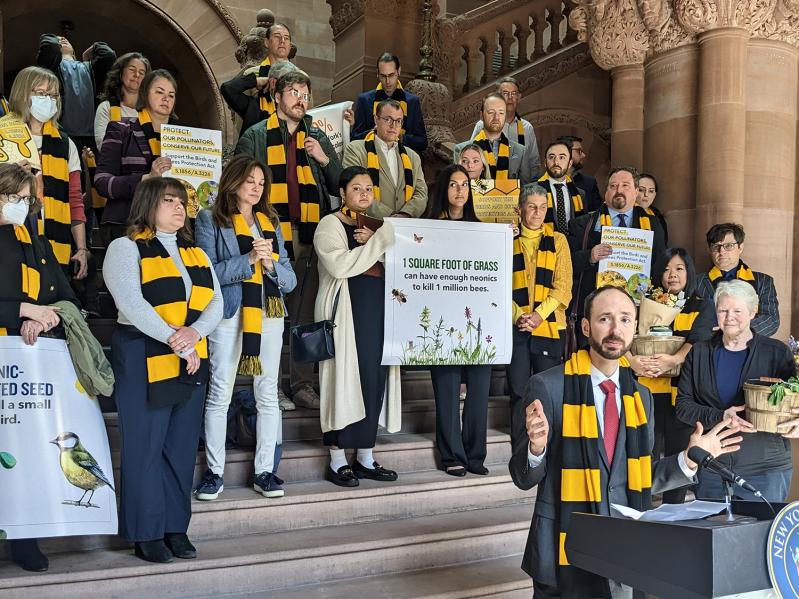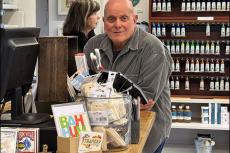Last week, the State Assembly passed the Birds and Bees Protection Act, which restricts the use of neonicotinoid pesticides (“neonics”). Neonics are commonly used on lawns to kill grubs, but they persist in the environment and are affecting populations of pollinators and causing water contamination.
Imidacloprid is the most used neonic and “the number-one insecticide detected in Long Island groundwater,” said Dan Raichel, acting director, pollinator initiative, for the National Resources Defense Council. A study published by the State Department of Environmental Conservation in March showed that it is also the number-one insecticide, by weight, used by the Island’s commercial applicators.
On Amazon, a gallon costs about $100.
Neonics are based on nicotine, a chemical familiar for its addictive qualities. They work by overstimulating insect nerves until the nerves eventually die. They were first introduced into the United States in 1994 and their usage has increased since.
The three major neonics were banned by Europe 10 years ago. Canada has been phasing them out. Despite the European ban, Mr. Raichel says the chemicals still show up in unpredictable hosts, such as seabirds. “It makes no sense. It shows how ubiquitous the contamination got and how it moves through the food web in unexpected ways.”
“This legislation is long overdue to protect the ecosystem,” said Assemblyman Fred W. Thiele Jr., a co-sponsor of the bill, in a phone call. “Last year it was rejected in the [State] Senate. This year I think it has a reasonable chance to pass there. I’m hopeful.”
“The largest concern for human health is pre-natal and early-life exposure,” said Mr. Raichel. “We’re seeing almost ubiquitous exposure in the human population. A study from last year looked at pregnant women in New York, and found neonics in over 95 percent of their bodies. We’re being exposed day in and day out. When you lose a nerve, you lose a nerve. That begins to build up.”
As of Jan. 1, the D.E.C. reclassified the most-used neonics from a general to a restricted use, meaning that they can only be “purchased, possessed, used, or applied by a certified pesticide applicator or the holder of a pesticide purchase permit.”
“We’re happy with the D.E.C. move,” said Mr. Raichel. “It’s good to get these products off the shelves at Home Depot, and it’s an acknowledgement by them that they’re concerned with these pesticides.”
However, because most landscapers and golf courses employ certified pesticide applicators, reclassification alone might not make a big dent in usage. The Birds and Bees Protection Act would go one step further than the D.E.C., and act as a full-stop prohibition on the use of neonics for turf and ornamental applications.
The D.E.C., through a spokesperson, refused to comment on “pending legislation.”
Though passed by the Assembly, the bill is not yet law. The State Senate needs to approve it, and then it must be signed by Governor Hochul.
Senator Anthony Palumbo, who represents both the North and South Forks, and whose vote could be crucial, is against the measure.
“My concerns with the Birds and Bees Protection Act align with those of the region’s farmers, as well as the legislation’s impact on the state’s ability to combat invasive species,” he said in a statement.
“As the Senator representing one of the largest agricultural producing regions in the state and countless vineyards, wineries and farms, my priority is to protect this vital industry and ensure that State Government does not enact policies that will cause further harm to the East End’s agricultural industries,” he stated.
“While I understand that there are discussions about amending the bill, until the agricultural community is comfortable with this legislation, I cannot give it my support.”
The agricultural community is concerned because, apart from turf and ornamental uses, the bill also targets neonicotinoid coverings on corn, soybean, and wheat seeds, bringing about strong opposition from the State Farm Bureau. Those crops, however, do not figure largely in Long Island’s agriculture scene, which skews heavily toward horticulture and vineyards.
“I’m not hearing from individual farmers that it affects them here on Long Island,” said Assemblyman Thiele. “We don’t grow the crops for which these chemicals are critical. The farm bureau may have a statewide position, but on Long Island, our reliance on groundwater makes us a little different than upstate. From my perspective, you have to balance the competing interests.”
The farm bureau has suggested that people write their legislators and include a sample letter on its website, which says, in part, “Neonicotinoid coated seeds are a crucial tool for farmers to protect their investment and crops against early disease and pest pressure.”
A 2020 Cornell University Neonicotinoid Assessment found, however, that neonics not only contribute to pollinator declines, but do not “consistently increase net income for New York field corn or soybean producers.” Treated seeds are used preventively, not as a response to a specific risk. Roughly 90 percent of field trials found no change in corn yields compared to chemical alternatives, or even to plots that used no insecticides at all.
“Where we see neonics more than anyplace else is on Eastern Long Island,” said Mr. Raichel. “They’re used on corn and soybean seeds, but quite extensively in lawn care for grubs and on golf courses. Wherever you have a golf course, that’s likely where you’re going to see a lot of these pesticides.”
Long Island rests on a single-source aquifer. Simply put, whatever goes into the ground will eventually end up in our drinking water. “Whether it’s a neonic or something else, you don’t want pesticides in your water,” said Mr. Raichel. “Particularly on Long Island, you have to ask yourself, is it worth it for a green lawn?”




